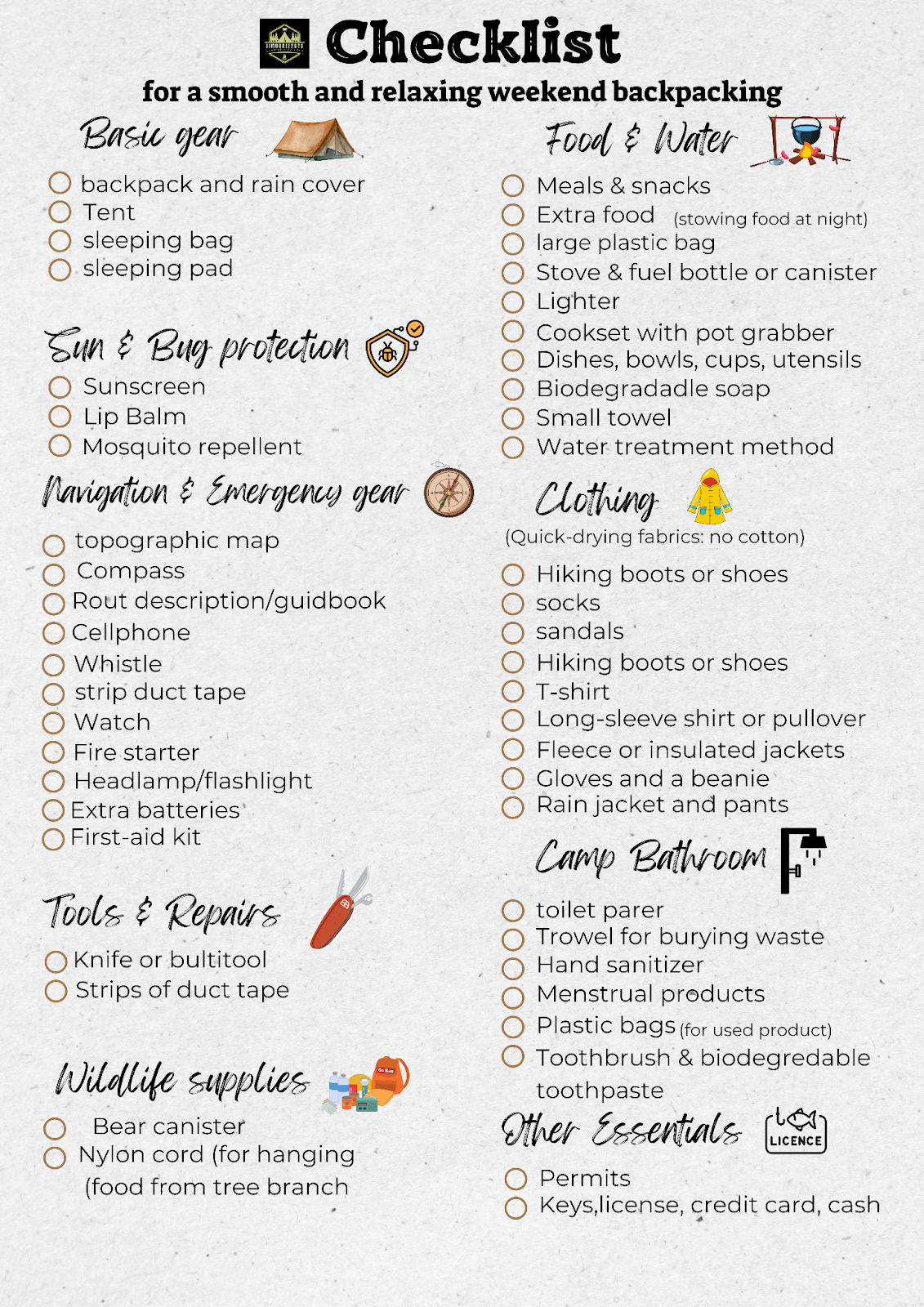Expert Advice/backpacking
Guide for Your First Backpacking Trip
This article is part of our blog series: How to choose a backpack
If you love camping and hiking, backpacking is the perfect way to elevate your outdoor adventures. It combines hiking with backcountry camping, allowing you to explore remote areas and enjoy a more immersive experience. Unlike day hiking, backpacking requires carrying all your essentials on your back, so careful packing is essential.
Getting Started:
Choose a simple destination: Start with short overnight hikes close to home.

Gather your gear: Borrow or find secondhand equipment to save costs.
Plan your meals: Opt for easy-to-prepare, just-add-water options or trail snacks from your local grocery store.
Prepare for the trip: Train with a fully loaded pack, secure permits, and review Leave No Trace principles.
Invite an experienced friend to guide you, or go solo for a rewarding challenge. Always bring a buddy for added safety and fun.
(Note: This guide focuses on backcountry backpacking, not urban travel-style backpacking.)
1: Select an Ideal Beginner Backpacking Location
Starting your backpacking journey with an easy route is essential for an enjoyable experience. Follow these guidelines to find the right destination:
Seek Local Expertise: Connect with seasoned hikers or outdoor enthusiasts for advice. Local guidebooks and hiking clubs can offer valuable recommendations.
Stay Nearby: Opt for a location close to home to reduce travel time and allow for a relaxed start. Arrive at camp well before dark.
Limit the Distance: Choose a route with minimal mileage, as carrying a heavier pack slows your pace compared to day hikes.
Minimize Elevation Changes: Select trails with gentle climbs to conserve energy and make the hike more enjoyable.
Pick Well-Used Trails: Popular routes with established campsites offer peace of mind, as help is more accessible if needed.
Confirm Water Access: Ensure a reliable water source near your campsite. Check with local authorities for updates on conditions.
Leave Pets and Kids Behind: For your first trip, consider going solo or with a fellow adult to keep things simple.
Choose Mild Weather: Plan for summer or pleasant conditions to maximize daylight and comfort. Always monitor weather forecasts.
Try Transition Sites: Walk-in campgrounds close to parking areas are great for testing your backpacking skills with minimal commitment.
By starting small and planning carefully, you’ll build confidence and create a positive first experience in the backcountry
2: Gear Up for Your First Backpacking Adventure
Starting backpacking doesn’t have to break the bank. Borrow or rent expensive items like a tent, sleeping bag, and sleeping pad. However, invest in properly fitting boots and, if possible, your backpack. Here’s what you’ll need:
Essential Backpacking Gear

Tent: Share a two-person tent for a lighter load and cost efficiency. A three-season tent (spring, summer, fall) is perfect for beginners. Skip the four-season option unless you’re heading into extreme conditions.
Backpack: Borrow a pack and test it loaded to about 30 pounds to ensure comfort. If buying, choose a model with ample support and padding. Ultralight packs can be tempting, but they often lack cushioning and structure—better suited for more experienced backpackers.
Sleeping Bag: A synthetic fill bag is an excellent starter option—durable, versatile, and budget-friendly. Evaluate the trade-offs between synthetic and downfall based on your expected weather conditions.
Sleeping Pad: Comfort is critical, and so is insulation. Closed-cell foam pads are light and affordable but firm. Self-inflating pads strike a great balance between cushioning and value. Avoid pool floats or uninsulated options—they won’t keep you warm.
Packing Tips
Since you’ll carry all your gear, prioritize lightweight and compact items. Car camping gear is often too bulky for backpacking. If hiking with a friend, share the load by dividing group essentials like tents and cooking supplies.
By carefully selecting gear that fits your needs, you’ll be ready to hit the trail and enjoy your first backpacking adventure comfortably!
Cook and Stay Hydrated: Essential Kitchen Gear for Your First Backpacking Trip

Proper planning and lightweight choices are key to successful meals and hydration on the trail. Here’s what you need to pack for cooking, eating, and purifying water:
Must-Have Gear for Cooking and Water Treatment
Stove: A single-burner stove under a pound is ideal for beginners. If buying, gas-canister stoves are user-friendly, affordable, and great for first-timers. Don't forget to pack a compatible, full-fuel canister to power your stove.
Water Treatment: Even clear water sources may harbor harmful contaminants. For simplicity, consider chemical treatments like tablets or drops—they’re lightweight and easy for beginners. Water filters are another reliable option if you can borrow one.
Kitchen Supplies: Avoid overpacking by bringing only what you need. Use thrifted or borrowed items to save money: a pot or pan for cooking, basic utensils, plates, and cups. Add a sponge, biodegradable soap, and a small towel for cleanup—always wash dishes away from water sources to minimize environmental impact.
Packing Pro Tips
Plan meals carefully and pack lightweight options. Compact, fuel-efficient stoves and minimalist cookware are your best bet for reducing pack weight. Always treat water to avoid health risks, no matter how pristine the source may appear.
By selecting practical and lightweight gear, you’ll be ready to cook delicious meals and stay hydrated on your first backpacking adventure!
What to Wear Backpacking: A Practical Guide

You don’t need to buy specialized hiking clothes for your first backpacking trip. Athletic wear made of moisture-wicking, quick-drying fabrics like nylon or polyester will work perfectly. Avoid cotton, as it retains moisture and dries slowly, which can lead to discomfort or even hypothermia in cold conditions.
Clothing Essentials by Layer
Base Layers: These are your long underwear, crucial for warmth during cold nights.
Hiking Layers: Opt for nylon pants (roll-up or zip-off), T-shirts, a sun shirt, and a sun hat to stay cool and protected during the day.
Insulation: A lightweight fleece, puffy jacket, warm hat, and gloves are essential for staying warm.
Rain Gear: Always pack a waterproof jacket, and bring rain pants depending on the forecast. These also help fend off mosquitoes.
Layering lets you adjust quickly to changing conditions, from chilly mornings to warm afternoons or sudden rainstorms.
Tips for Choosing Backpacking Footwear
Your footwear is vital for a successful trip. Some prefer sturdy over-the-ankle boots for support, while others choose lightweight trail running shoes for flexibility. Ensure they’re broken in before your trip.
Socks: Use wool or synthetic socks to prevent blisters and keep feet dry.
Camp Shoes: Bring ultralight water sandals or shoes for camp comfort and stream crossings.
With the right clothing and footwear, you’ll stay comfortable, protected, and ready to tackle your backpacking adventure.

Tip: When you return from your trip, use your checklist as you unpack. Note which items were useful and which weren’t. Over time, this process will help you create a personalized, efficient packing list tailored to your needs.
Plan Your Backpacking Food

For a short backpacking trip, plan for dinner, breakfast, and a couple of lunches. Lightweight, freeze-dried meals are convenient but expensive. Grocery store alternatives are budget-friendly and versatile. Since you won’t have refrigeration, avoid perishables like fresh eggs and opt for shelf-stable items. Here are some detailed tips:
Dinner: Choose one-pot meals like packaged rice or noodle dishes. For easy packing, transfer boxed meals into resealable bags.
Lunches and snacks: High-calorie, high-protein items such as energy bars, trail mix, bagels, jerky, dried fruit, and nuts are ideal. Make lunch simple with quick snacks and a longer trailside rest.
Breakfast: Options range from hot oatmeal and breakfast bars to cooked meals like pancakes. Balance the benefits of a warm start with your need for an early trailhead departure. For caffeine, pack instant coffee or tea bags.
Wildlife Precautions
On the trail: Keep a safe distance from animals and avoid separating a mother from her young.
At camp: Secure all food and scented items away from your sleeping area. Use a bear canister or hang food in a stuff sack from a tree branch to deter rodents and larger wildlife.
By packing thoughtfully and following these precautions, you’ll stay fueled and safe throughout your trip.
Preparing for Your First Backpacking Adventure




